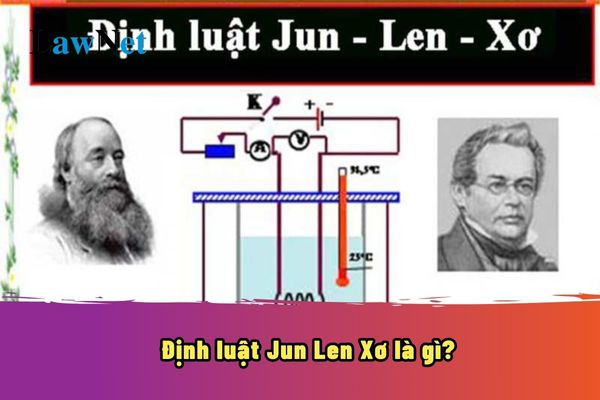What is the Joule-Lenz law? What is the formula of the Joule-Lenz law? What are the 2 educational objectives of grade 10 Physics in Vietnam?
What is the Joule-Lenz law? What is the formula of the Joule-Lenz law?
Joule's Law of Heating, often referred to as Joule-Lenz Law, is one of the significant laws in electrical physics, with numerous practical applications in everyday life. Understanding this law helps us use electrical energy more safely and efficiently.
Grade 10 students can refer to the explanation of Joule-Lenz law and its formula below:
What is the Joule-Lenz law? What is the formula of the Joule-Lenz law?
Joule-Lenz Law describes the relationship between the heat emitted from a conductor when an electric current passes through it, the current's intensity, the conductor's resistance, and the duration the current passes through.
*Statement:
The heat emitted in a conductor when an electric current passes through is proportional to the square of the current's intensity, the resistance of the conductor, and the time the current passes through.
*Formula:
Q = I²Rt
*Where:
Q: Heat emitted (Joule, J)
I: Electric current intensity (Ampere, A)
R: Resistance of the conductor (Ohm, Ω)
t: Time the current passes through (seconds, s)
*Significance of the formula:
I²: Indicates that the heat emitted increases significantly as the current intensity increases.
R: The greater the resistance, the more heat is emitted.
t: The longer the current passes through, the more heat is emitted.
*Applications:
- Calculating emitted heat: This formula helps calculate the amount of heat emitted from a specific conductor when the current and resistance parameters are known.
- Designing electrical devices: This formula is used to design electrical devices so that the heat emitted is not excessive, preventing fires and explosions.
- Explaining thermal phenomena in electrical circuits: This formula helps explain why electrical devices like bulbs heat up when an electric current passes through them.
*Example:
A bulb with a resistance of 200Ω is connected to a 220V power source for 10 minutes. Calculate the heat emitted from the bulb.
Solution:
Electric current through the bulb: I = U/R = 220/200 = 1.1A
Time: t = 10 minutes = 600 seconds
Emitted heat: Q = I²Rt = 1.1² * 200 * 600 = 145200 J
*Note: Information is for reference only.

What is the Joule-Lenz law? What is the formula of the Joule-Lenz law? What are the 2 educational objectives of grade 10 Physics in Vietnam? (Image from the Internet)
What are the 2 educational objectives of grade 10 Physics in Vietnam?
According to the provisions in Section 3 of the General Education Program in Physics, promulgated together with Circular 32/2018/TT-BGDDT, the educational objectives for Physics at upper secondary level are as follows:
[1] Along with other subjects and educational activities, help students form and develop key qualities and general competencies as specified in the overall program.
[2] Help students form and develop physics competencies, with manifestations including:
+ Acquiring core general knowledge and skills regarding: physical system models; energy and waves; forces and fields;
+ Applying some scientific process skills to explore and solve problems from a physics perspective;
+ Applying some knowledge and skills in practice, interacting with nature in harmony with the requirements of sustainable social development and environmental protection;
+ Recognizing personal abilities, talents, orienting career paths, and making study and practice plans that align with career orientation requirements.
What are regulations on assessment of the educational outcome of grade 10 Physics in Vietnam?
Based on Section 7 of the General Education Program in Physics, promulgated together with Circular 32/2018/TT-BGDDT, the assessment criteria for the educational outcome of grade 10 Physics in Vietnam are as follows:
(1) General orientation
- The objective of educational outcome assessment is to collect honest, timely, and valuable information about the extent to which students meet required outcomes and their progress. Through this, guide learning activities and adjust teaching activities.
- The assessment foundation in Physics is the required outcomes for general and physics competencies specified in the overall program and the Physics program. The assessment targets are the learning process, practice, and student products through learning Physics.
- To assess students' competencies, it is essential to design situations that present problems requiring resolution, helping students showcase their capabilities. Moreover, it is crucial to identify and select appropriate methods, tools, and assessment criteria.
(2) Focus and assessment methods
- The focus of learning outcome assessment in Physics is on problem recognition, problem-solving abilities, and practical and experimental skills, specifically core understanding of:
+ Physical system models, energy and waves, forces and fields, physics-related careers;
+ Experimental skills, practical skills, science exploration, application of learned knowledge to explain simple physical phenomena, initially solve some practical problems, and appropriate interaction with the natural environment.
- Reasonable coordination of teacher assessments with peer assessments and student self-assessments;
- Assessment through observing group activities in and outside the classroom, observing practical and experimental manipulations, and analyzing presentations;
- Assessment through oral exams, written exercises, tests, notebooks, practice reports, project outcomes, research topics, and other learning records;
- Assessment through a combination of essay writing and multiple-choice tests, process evaluation, summative evaluation, and regular periodic evaluations.

